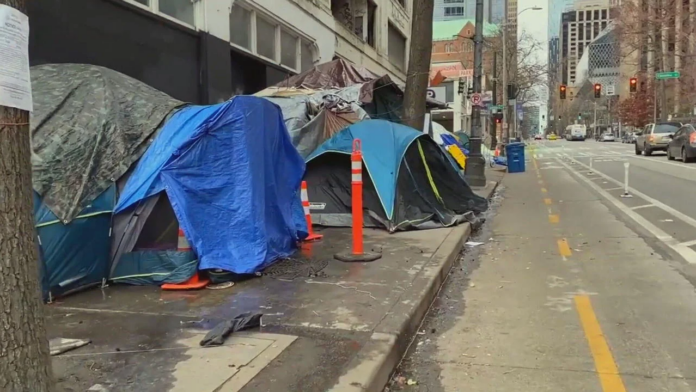Homelessness in the US has reached record levels in 2024, with an 18% increase from the previous year, according to a sobering report by the US Department of Housing and Urban Development (HUD). The report highlights that 771,480 individuals, or 23 out of every 10,000 people, experienced homelessness this year. This dramatic surge, the largest in decades, underscores the compounding effects of systemic issues such as unaffordable housing, inflation, and immigration pressures.
Understanding the Scope of the Crisis
The 2024 HUD report revealed a stark reality: the United States is grappling with its worst homelessness crisis in recent memory. The record-breaking numbers paint a bleak picture of a country struggling to provide basic housing security for its vulnerable populations.
The crisis impacts a diverse range of groups, including:
- Families with Children: Often the hardest hit, these families face unique challenges such as securing shelter, maintaining stability, and ensuring children’s access to education.
- Veterans: Despite federal programs aimed at reducing veteran homelessness, many former service members remain on the streets, struggling with mental health issues and limited resources.
- Domestic Violence Survivors: Women and children fleeing abusive homes frequently end up without stable housing due to a lack of emergency shelters and long-term housing solutions.

Key Factors Driving the Rise in Homelessness
HUD attributes the alarming increase in homelessness to several interconnected factors:
- Unaffordable Housing:
The housing market in many parts of the country has become inaccessible to low-income families. With rents continuing to rise, housing costs have outpaced wage growth, leaving many unable to keep up. - Inflation and Economic Pressures:
Persistent inflation has eroded purchasing power, making essentials like food, healthcare, and housing more expensive. Many households that were already on the brink of financial instability have been pushed into homelessness. - Post-Pandemic Economic Challenges:
The expiration of pandemic-era relief programs such as eviction moratoriums and emergency rental assistance has left many struggling to stay housed. - Rising Immigration:
Increased immigration has added pressure to limited housing resources, especially in urban centers, where many immigrants settle. Language barriers, employment instability, and lack of documentation exacerbate the problem for this group. - Mental Health and Substance Abuse Issues:
Many individuals experiencing homelessness also face untreated mental health disorders or substance abuse issues, creating a cycle that is hard to break without targeted interventions.
The Ripple Effects on Communities
The homelessness crisis has far-reaching implications for communities across the United States:
- Public Resources: Shelters, food banks, and healthcare facilities are overwhelmed, unable to meet the growing demand for services.
- Urban Landscapes: Homeless encampments in cities such as Los Angeles, New York, and San Francisco have become increasingly visible, leading to public safety concerns and stigmatization of those experiencing homelessness.
- Economic Costs: The rise in homelessness increases healthcare costs, law enforcement spending, and the need for emergency services.
Federal and Local Responses
The HUD report has sparked discussions on the urgent need for a coordinated, multi-faceted response to tackle homelessness at its root. Proposed solutions include:
- Expanding Affordable Housing Initiatives:
Governments and private sectors must collaborate to build more affordable housing units and increase funding for rental assistance programs. - Strengthening Tenant Protections:
Implementing stricter eviction protections and rent control measures can prevent at-risk families from losing their homes. - Investing in Mental Health Services:
Expanding access to mental health care and addiction treatment can address one of the underlying causes of homelessness for many individuals. - Reforming Immigration Policies:
Ensuring that immigrants have access to legal pathways for work and housing can reduce the strain on public resources. - Innovative Solutions:
Some cities are experimenting with initiatives such as tiny home communities, conversion of unused buildings into shelters, and providing direct cash transfers to homeless individuals.
A Historic Turning Point
Homelessness in the US is not just a statistic; it is a humanitarian crisis that demands immediate action. The 18% surge in homelessness represents more than just numbers—it reflects a failure to address systemic inequalities that leave millions without a place to call home.
As the country moves forward, policymakers, community leaders, and citizens must work together to implement comprehensive solutions that address both immediate needs and long-term challenges. With targeted interventions, increased funding, and a commitment to social equity, the United States has an opportunity to reverse this trend and ensure housing security for all.
The fight against homelessness is a fight for dignity, equality, and the fundamental human right to shelter.

